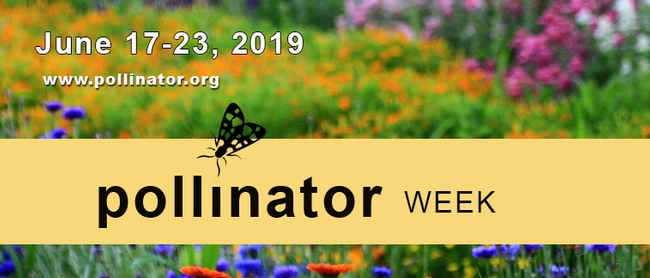- Author: Ed Perry
Although many coast redwoods (Sequoia sempervirons) appear to grow well in some parts of the San Joaquin Valley, the UCCE Master Gardeners are often contacted for help diagnosing redwoods with dead branches that seem to be dying.
It's important to remember that coast redwoods are native to the coasts of Central and Northern California. In this environment, the trees are shaded by each other and experience significant cooling from fog. They also receive moisture from fog drip and high rainfall. In their native forests, redwoods grow with large amounts of forest litter over their roots.
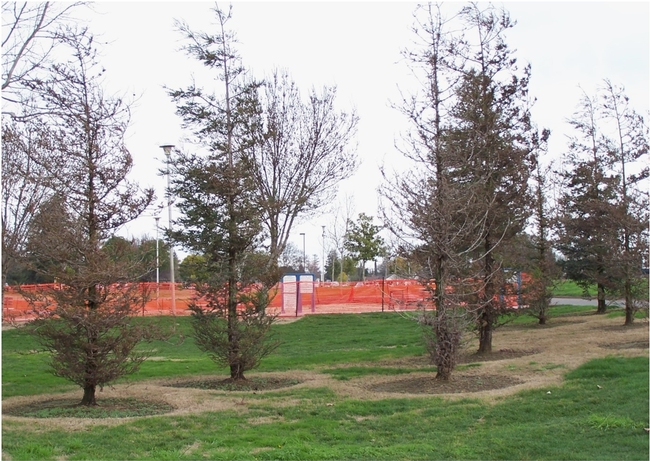
While coast redwood trees are susceptible to some serious diseases, they are most often injured or killed by abiotic (non living) problems. High soil salinity caused by excess sodium (alkaline soil), and toxicity caused by high concentrations of specific ions such as boron and chlorides will stunt their growth and cause their leaves to turn yellow and “burn.” They grow poorly in heavy soils that are too wet, or in dry, compacted soils with poor drainage. Coast redwoods are also susceptible to iron deficiency, especially in high pH soils. They may be injured by freezing temperatures, especially in dry soil. Because they are adapted to a cool, moist environment, they will develop brown and scorched leaves during our hot and dry summers, especially if they're not adequately watered. Drought stressed trees may then be attacked by bark beetles.
In dry or compacted soils the trees grow slowly and their trunks develop a distinct taper. Under ideal soil and moisture conditions, such as along portions of the California Coast, the trunks will be nearly the same diameter from the base of the tree to several feet high. Some brown foliage in the interior of the tree is normal. In fact, it is normal for the oldest leaves to turn yellow, then brown, and finally drop from the tree in late summer and early fall. It is also normal for short twigs to turn brown and fall. New growth at the ends of branches indicates that the branches are alive and healthy, despite some dieback of twigs and leaves.
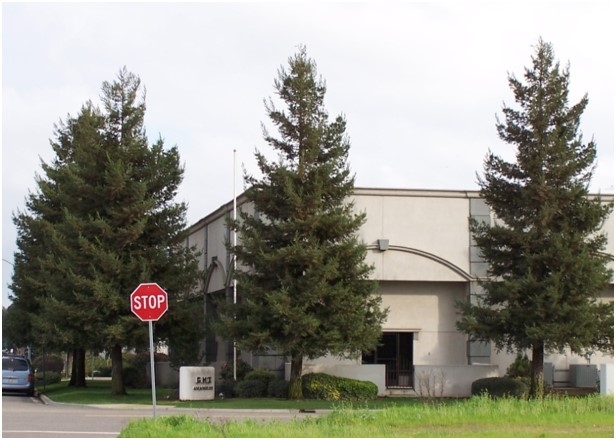
As mentioned, coast redwoods are susceptible to some diseases. In Stanislaus County, redwoods infected by Botryosphaeria canker (Botryosphaeria dothidea), crown rot (Phytophthora sp.) and Armellaria root rot (Armillaria mellea) have been identified. However, these diseases are relatively uncommon on redwoods here. If you're trying to diagnose a redwood problem, be sure to consider soil and water-related problems first.
Redwoods are forest trees. We have cultivated them for use in non-forest landscapes as street and park trees, and as specimen trees. These conditions are not always favorable to their growth or long term establishment. They grow best with shade, cool root systems, abundant mulch, and continual moisture that is relatively salt free. If you can create some of these conditions in the landscape, redwood culture and disease management will be much less problematic.
Ed Perry is the emeritus Environmental Horticultural Advisor for University of California Cooperative Extension (UCCE) in Stanislaus County where he worked for over 30 years.
- Author: Anne E Schellman
Every time you eat a fruit, vegetable, or nut, you may want to thank a pollinator. Without them, our diet would lack many of the vitamins and minerals we need to survive.
Often honeybees get all the kudos for pollinating, and they do a great job. But there are other pollinators involved too, including bumblebees, other species of bees*, birds, bats, butterflies, moths, wasps, beetles, and even flies.
June 17-23, 2019 is Pollinator Week, but you can celebrate pollinators all year long by creating a pollinator-friendly landscape. Here is a short list of things you can do now:
- Situate your garden in a sunny location
- Provide a variety of habitats such as shrubs, tall grasses, and low growing plants
- Leave some area of your ground bare (for ground-nesting bees & wasps)
- Use plants that provide pollen and nectar
- Use a mix of plants that bloom throughout the growing season
- Choose less toxic pesticide options and apply them in the early morning or evening
If you have questions or need assistance with any of these suggestions, feel free to contact the UCCE Stanislaus County Master Gardeners at (209) 525-6800 or ucmgstanislaus@ucanr.edu
Please join us when we recommend pollinator-friendly plants during our next free class on Low Water Use Landscaping on Thursday, June 27 from 6:00-7:30 in Modesto. Sign up at http://ucanr.edu/lowwater2019
In the fall we plan to hold a class all about pollinators, so stay tuned!
* Visit the UC Berkeley Urban Bee Lab Common Bee Groups of California to see photos of other types of bees you may find in your landscape. http://www.helpabee.org/common-bee-groups-of-ca.html
- Author: Anne E Schellman
On June 5, the University of California Cooperative Extension (UCCE) Stanislaus County Master Gardener Program hosted an online giving event called #BigDigDay. This was an opportunity for community members to invest in our new local program.
Together, we raised a total of $630! These funds will go towards helping us purchase needed items like a pop-up-tent, tables, chairs, brochure holders, and other materials needed for outdoor events, workshops, and classes.
Our twenty-three brand new UCCE Master Gardener volunteers will soon (July) be out in the community! Please stop by and say “hello” if you see them at the Stanislaus County Fair, a local farmers market, local nursery, or local library.
If you are interested in becoming a UCCE Master Gardener, visit our website and fill out our online interest survey. We will be recruiting for our next class soon!
If you missed out on #BigDigDay, you don't have to wait until next year to give to our program. Visit the UC Cooperative Extension website for Stanislaus County at https://donate.ucanr.edu/pages/uccestanislaus and choose “UCCE Stanislaus County - Master Gardener Fund” from the designation heading.
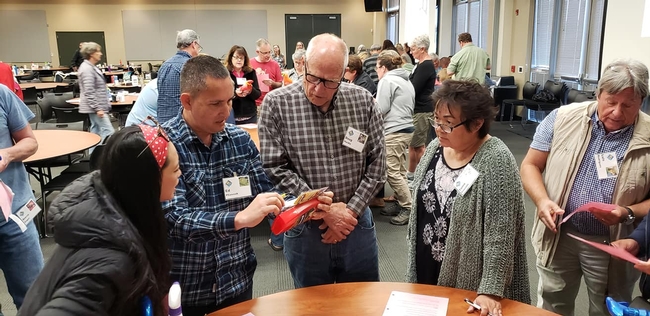
- Author: Anne E Schellman
Want to save water* in your home landscape but aren't sure how to get started? The Stanislaus UCCE Master Gardeners have a free class that can help! We will cover:
- Small irrigation changes you can make now to start saving water
- How to design a low water use landscape
- Irrigation tips
- Plants that thrive in low water landscapes
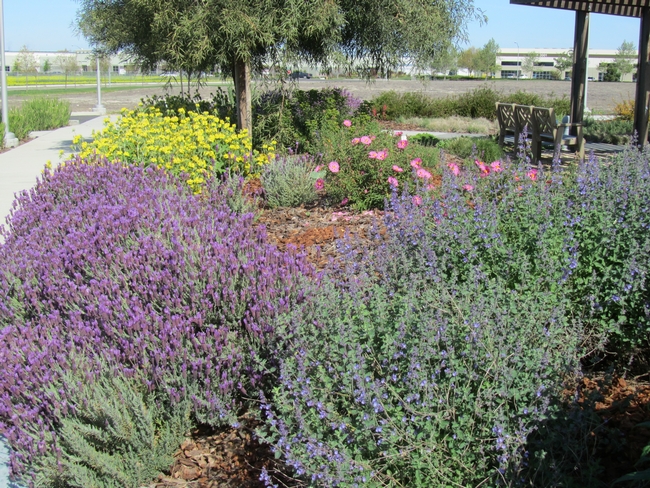
We will also answer these questions:
- Should I "break up with" (tear out) my lawn?
- What kind of water rebates are available if I do?
- How can I save water and keep my lawn?
- Are cacti and succulents the only plants I can grow to save water?
Class Details
Thursday, June 27, 2019 6:00-7:30 p.m.
Stanislaus County Agricultural Center, Harvest Hall Rooms D&E
Sign up at http://ucanr.edu/lowwater2019 or call Anne Schellman at (209) 525-6862 to reserve your space.
*Over half the water used in urban homes goes towards outdoor landscapes.
Source: Public Policy Institute of California https://www.ppic.org/publication/water-use-in-california
- Author: Anne E Schellman
As many readers know, University of California Cooperative Extension (UCCE) in Stanislaus County recently launched a Master Gardener Program.
This statewide program trains volunteers who then teach residents about composting, using less water in the landscape, growing fruits and vegetables, and how to safely and effectively manage pests in the home and landscape.
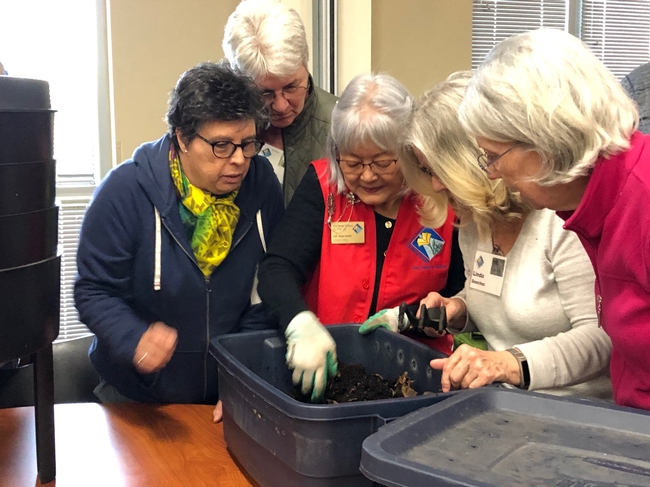
Our program is just getting started and it could use your help. We are asking for support on June 5, 2019 on Big Dig Day—a day to “dig in the soil, dig in your heart, and dig in your wallet to support a program you care about!”
We hope you can help us with our mission to extend research-based knowledge and information on home horticulture, pest management, and sustainable landscaping practices to the community.
Our program needs funds to purchase supplies such as pop-up tents, tables, chairs, banners, and tablecloths for farmers markets and other events. We can also use funds to help provide partial scholarships for residents who might not be able to afford the fee to enroll in our program.
Please join anytime during the 24-hour giving day. If you make a donation, please share your excitement on social media using #BigDigDay and #DigDeep.
Visit the our #BigDigDay page and select “Master Gardener Program” and then “Stanislaus” from the drop-down menu anytime from now until June 5.
UCCE is a division of Agricultural and Natural Resources (UCANR).

